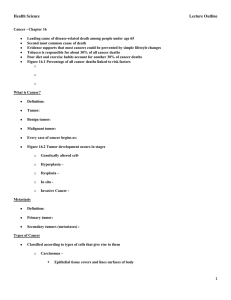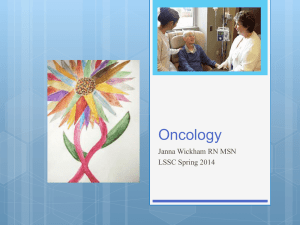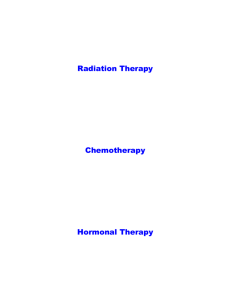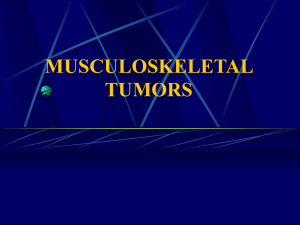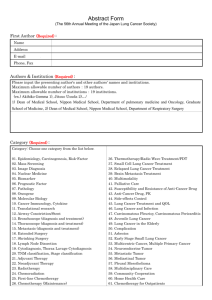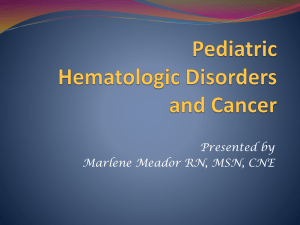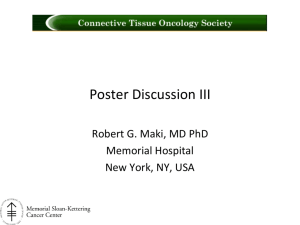General Concepts of Oncology Nursing
advertisement
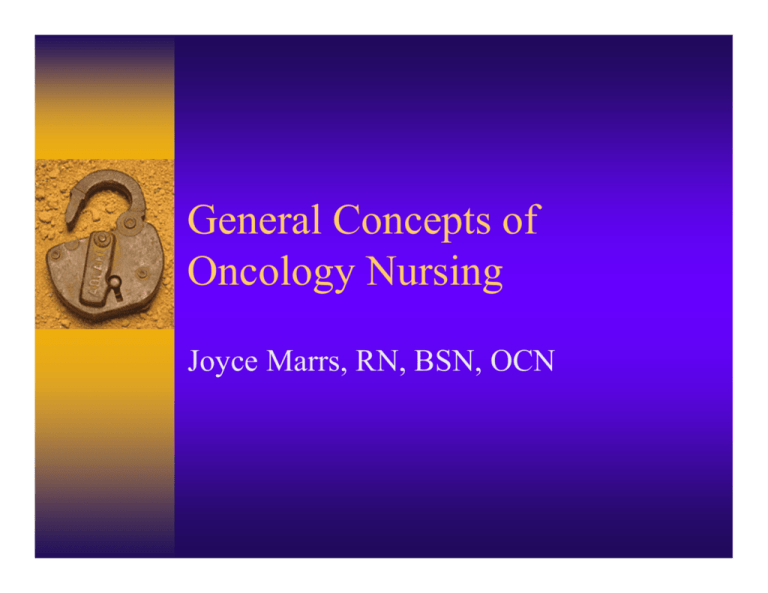
General Concepts of Oncology Nursing Joyce Marrs, RN, BSN, OCN Top Ten Reasons 10. No more bedpans, no more mitered corners. 9. The excuse “Chemo Brain” sounds better than “I’m Blonde.” 8. Trying to beat Dracula at blood drawing competition, good place to practice. 7. Will never need to buy school pens again. 6. Cross multiply and divide was my favorite math equation in school. Top Ten Reasons 5. Wearing scrubs to work is like being in my PJ’s all day. 4. I consider hanging IV bags all day my daily stretching exercise. 3. Lunch is usually provided, provided you have time to eat. 2. I’m too young to be a greeter at WalMart. 1. It’s the best job I’ve ever had. Estimated 2002 New Cases ♦ Male: ♦ Female: ♦ Prostate- 30% ♦ Breast- 31% ♦ Lung/Bronchus- 14% ♦ Lung/Bronchus- 12% ♦ Colon/Rectum- 11% ♦ Colon/Rectum- 12% ♦ Urinary/Bladder- 7% ♦ Uterine- 6% ♦ Melanoma- 5% ♦ Non-Hodgkin’s- 4% ♦ Non-Hodgkin’s- 4% ♦ Melanoma- 4% ♦ Kidney- 3% ♦ Ovary- 4% Estimated 2002 Deaths ♦ Male: ♦ Female: ♦ Lung/Bronchus- 31% ♦ Lung/Bronchus- 25% ♦ Prostate- 11% ♦ Breast- 15% ♦ Colon/Rectum- 10% ♦ Colon/Rectum- 11% ♦ Pancreas- 5% ♦ Pancreas- 6% ♦ Non-Hodgkin’s- 5% ♦ Ovary- 5% ♦ Leukemia- 4% ♦ Non-Hodgkin’s- 4% ♦ Esophagus- 3% ♦ Leukemia- 4% Cultural Considerations: ♦ African-Americans have Higher Incidence ♦ African-Americans have Higher Rate of Death ♦ Native Americans have Poorer Survival even though they have Lower Incidence An Organized Society ♦ Tight Regulation of – Cell Division – Proliferation – Differentiation • Goal is to maintain balance Review of Definitions ♦ Neoplasm ♦ Tumor ♦ Oncos ♦ Oncology ♦ Cancer Terminology ♦ Benign Tumors ♦ Malignant Tumors ♦ Add “oma” to the cell ♦ Add “carcinoma” to of origin ♦ Capable of Mitosis ♦ Adhere Tightly ♦ Not capable of Metastasis cellular origin ♦ Have no Purpose ♦ Complete Cell Cycle ♦ Anaplastic ♦ Adhere Loosely ♦ Can Spread Terminology: Benign or Cancerous ♦ Benign ♦ Cancerous ♦ Gland/Duct: – Adenoma Melanocyte: Nevus Fatty Tissue: Lipoma Muscle: Leiomyoma ♦ Gland/Duct: – Adenocarcinoma Melanocyte: Malignant Melanoma Fatty Tissue: Liposarcoma Muscle: Leiomyosarcoma Theories of Carcinogensis ♦ Initiation-Promotion-Progression Model ♦ Oncogene and Tumor suppressor gene Model ♦ Disease of Differentiation ♦ Stem Cell Disease ♦ Disease of Intercellular Communication Promotion Initiation Promotion Promotion Normal Altered Cell Tumor Higher Grade Malignancy Progression Metastasis Body Defense: Immune Surveillance System ♦ Recognition of non-self ♦ Tumor Antigens found on certain Ca Cells – CEA – PSA – CA 27-29 – CA 127 – CA 19-9 Tumor Staging ♦ T-Tumor ♦ N- Nodes ♦ M- Metastasis – T 0-3 – N 0-2 – M 0-2 Tumor Grading ♦ Well Differentiated ♦ Moderately Differentiated ♦ Poorly Differentiated ♦ Anaplastic Risk Factors ♦ Environmental Risk Factors ♦ Personal Behaviors ♦ Occupation ♦ Hormones Risk Factor Reduction ♦ Lifestyle Modification – Eliminate tobacco use – Moderate alcohol consumption – Diet – Exposure to Ultraviolet Light Nursing Impact on Cancer: Primary Prevention ♦ Educate, Educate, Educate ♦ Warning Signs of Cancer: – Change in Bowel or Bladder – A sore that does not heal – Unusual bleeding or discharge – Thickening or a lump in the breast or elsewhere – Indigestion or difficulty swallowing – Obvious change in mole or wart – Nagging cough or hoarseness Signs of Cancer ♦ Pain ♦ Fatigue ♦ Cachexia ♦ Anemia ♦ Infection ♦ Leukopenia and Thrombocytopenia ♦ Paraneoplastic Syndromes Primary Prevention: Screenings ♦ Promote Lifestyle changes that reduce the risk of developing cancer ♦ Colon and Rectal: Guiac testing and DRE annually at age 40, sigmoidoscopy age 50. ♦ Prostate: PSA and DRE annually age 50. ♦ Cervical: Pap test and pelvic exam yearly. ♦ Breast: Monthly SBE, Yearly Breast exam, and mammography. Secondary Prevention: After the diagnosis ♦ Surgery ♦ Radiation ♦ Chemotherapy or Biotherapy ♦ Nursing responsibility is to educate the patient to help prevent against further problems. Assess, Intervene, and Monitor Surgical Goals CURE PALLIATION Rehabillitation Supportive Care Radiation Therapy ♦ External Radiation ♦ Internal Radiation – Brachytherapy Side Effects of Radiation ♦ Fatigue ♦ Anorexia ♦ Skin Reactions ♦ Bone Marrow Suppression Patient Education ♦ What to expect ♦ How to care for the area ♦ What precautions are needed Fatigue Management ♦ Diet ♦ Exercise ♦ Fluids ♦ Journals ♦ Balance of Rest and Activity Skin Reaction Management ♦ Dry desquamation: Use lotion without irritating additives ♦ Wet desquamation: Keep clean and protect against infection. Chemotherapy ♦ Systemic Treatment: Affects the cellular level. – Cell Cycle Specific • Antimetabolites: Methotrexate, 5-FU, Fludara – Cell Cycle Non-Specific • Antitumor Metabolites: Adriamycin, Bleomycin • Alkylating Agents: Cytoxan, Cisplat, Carboplatin Method of Administration ♦ Intravenous: – Infusion Port, PICC line, Mid-line ♦ Intramuscular ♦ Subcutaneous ♦ Oral ♦ Intrathecal ♦ Intracavitary ♦ Topical Nursing Assessment for Chemotherapy Administration ♦ Venous Status ♦ Oral Cavity Status ♦ GI Status ♦ Hematological Status ♦ Psychosocial Issues ♦ Educational Needs Safe Handling Practice ♦ Prepare Chemotherapy in Biological Safety Cabinet ♦ Use Personal Protective Equipment: Gown, Gloves, Plastic backed Liner ♦ Dispose in Approved Containers ♦ Spill Kit Available Patient Teaching Guidelines ♦ For 48 Hours following Chemo: – Flush Toilet Twice – Rinse Toilet with Bleach Once a Day – Caregiver should wear Gloves, if in contact with any body fluids – Use Condom for Sexual Interaction Patient Teaching Guidelines ♦ Between Chemotherapy Sessions: – Weekly CBC – NADIR – Expectation of Side Effect Timing – What to Report Managing Side Effects ♦ Fatigue ♦ Nausea and Vomiting ♦ Alopecia ♦ Diarrhea ♦ Stomatitis ♦ Bone Marrow Suppression ♦ Peripheral Neuropathy Intimacy ♦ Body Image Changes ♦ Role Changes ♦ Pregnancy Concerns ♦ When to Abstain From Sexual Intercourse ♦ Managing Patient Concerns: P-LI-SS-IT ♦ Use Open Ended Questions in Discussion with Patient Biological Therapy ♦ Interferons ♦ Interleukins ♦ Monoclonal Antibodies Hematopoietic Growth Factors ♦ G-CSF (Granulocyte Colony Stimulating Factor) ♦ GM-CSF (Granulocyte-Macrophage CSF) ♦ M-CSF (Macrophage CSF) ♦ Multicolony Stimulating Factor ♦ Erythropoietin ♦ Neumega Bone Marrow Transplantation ♦ Allogeneic ♦ Autologous ♦ Syngeneic ♦ Peripheral Stem Cell Transplantation Alternative/Complimentary Therapy ♦ Herbal Supplements ♦ Special Diets: Macrobiotics ♦ Vitamin Therapy ♦ Relaxation Therapy ♦ Guided Imagery ♦ Massage Therapy Oncologic Emergencies ♦ Superior Vena Cava Syndrome ♦ Hypercalcemia ♦ Tumor Lysis Syndrome ♦ Spinal Cord Compression ♦ SIADH Superior Vena Cava Syndrome ♦ SVC – Thin-walled – Low-pressure vessel – Collapses easily with external pressure – Clinical picture is due to venous hypertension Hypercalcemia ♦ Normal serum calcium 9-11 mg/dl ♦ If ionized calcium level not done, check albumin ♦ If not properly treated: 50% mortality rate Tumor Lysis Syndrome ♦ Metabolic Complication of Treatment ♦ High Risk Individuals are those with bulky disease that is responsive to therapy. ♦ Caused by the breakdown of tumor cells. ♦ Can be Prevented Spinal Cord Compression ♦ Occurs in Approximately 10-15% of oncology patients. ♦ Results from direct extension of nodes to spinal cord or metastatic involvement. – 70% Thoracic area – 20% Lumbosacral area – 10% Cervical area SIADH ♦ Syndrome of Inappropriate Antidiuretic Hormone – Results in a Low Sodium Level – Frequent Disorder seen in Lung Cancer – Treated by restricting fluid or administering 3% NaCl intravenously – Slowly raise sodium level to reduce risk of cerebral edema Nursing Management: Tertiary Care/ Palliation ♦ When to Refer to Hospice or Palliative Care? – Symptom Management – Psychological Support Tertiary Care: Pain Management ♦ Assessment: Location, Duration, Radiation, Measures used. ♦ WHO pain relief ladder – Step 1: Non-opioid, Adjuvant – Step 2: Addition of Opioid – Step 3: Opioid, Non-opiod, Adjuvant, Assess need for additional pain control measures such as nerve block, epidural catheter Maintaining Your Enthusiasm ♦ Remember there is Hope and Optimism ♦ Empower your Patient ♦ Help your patient to live with, through, and beyond the diagnosis of cancer! ♦ Take the time to listen, you have just given that patient something priceless. ♦ You may be only a temporary part of the journey, make it a pleasant one. Great Web Sites ♦ www.ons.org ♦ www.asco.org ♦ www.plwc.org ♦ www.cansearch.org ♦ www.patientadvocate.org ♦ www.phrma.org ♦ www.cancer.org Developing Your Potential ♦ Join your Professional Nursing Organization: Sigma Theta Tau ♦ Become an Active Participant in a Local Organization ♦ Take Advantage of Learning Opportunities ♦ Find a Mentor: www.ons.org Student’s Virtual Community ♦ Be Involved!
